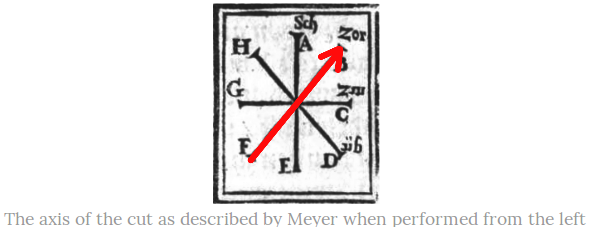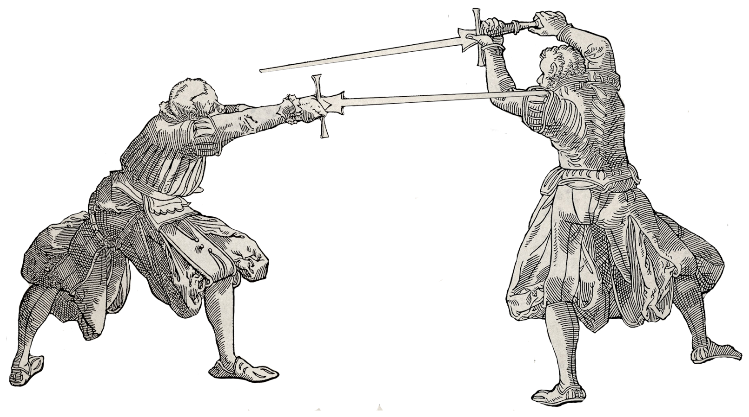Unterhauw
(→Application 2: Unterhauw Parry) |
(→Application 2: Unterhauw Versetzen) |
||
| Line 68: | Line 68: | ||
Perform this also from the opposite side. | Perform this also from the opposite side. | ||
| − | ====Application 2: Unterhauw [[Versetzen]]==== | + | ====Application 2: Unterhauw [[Versetzen]] & [[Zirckel]]==== |
In this application the cut is being used as a [[Provoker, Hitter, & Taker|Taker]] and [[Provoker, Hitter, & Taker|Hitter]] simultaneously in the [[Stages of the Exchange|Onset]]. In this case the fencer is acting in the [[Vor, Nach, Indes, & Gleich|Nach]] at the beginning of the technique. | In this application the cut is being used as a [[Provoker, Hitter, & Taker|Taker]] and [[Provoker, Hitter, & Taker|Hitter]] simultaneously in the [[Stages of the Exchange|Onset]]. In this case the fencer is acting in the [[Vor, Nach, Indes, & Gleich|Nach]] at the beginning of the technique. | ||
| Line 78: | Line 78: | ||
|- | |- | ||
| [[Vom tag]], left leg forward | | [[Vom tag]], left leg forward | ||
| − | | [[ | + | | [[Nebenhut]], right leg forward |
|- | |- | ||
| [[Passing Step]] with the right foot, [[Zornhauw]] to the upper left opening. | | [[Passing Step]] with the right foot, [[Zornhauw]] to the upper left opening. | ||
| − | | [[Side Step]] | + | | [[Side Step]] left with the left leg, Unterhauw to parry the blade up into [[Einhorn]] in a powerful taking out from below. |
|- | |- | ||
| − | | | + | | |
| − | | | + | | Cut back down with the false edge toward their right ear with crossed hands. |
| + | |- | ||
| + | | "Wipe" the falling blade away down to the right side with a parry. | ||
| + | | [[Passing Step]] back with the left foot, letting the blade fall past their right side, all the way around in a circle [[Zirckel]], and cutting over with an [[Oberhauw]] as you withdraw [[Abzug]]. | ||
|} | |} | ||
Revision as of 04:15, 12 June 2019
Contents |
Under Strike
Longsword
The unterhauw is a diagonal strike following the same line as the zornhauw, but rising up from below instead of descending.
At a Glance
- Diagonally upward cut, attacking the lower openings.
- Guard transitions: Nebenhut – Einhorn
- Advantages: Allows cuts under the arms of an attacker, can be used as a rising parry for all cuts to the upper openings.
- Disadvantages: Tends to be slightly slower and shorter reaching than cuts from above.
Execution
The canonical unterhauw is performed as follows.
Full Cut
- Begin in nebenhut, the blade beside you, true edge facing forward.
- Begin to bring the sword forward and up along the diagonal line.
- When the blade has passed the hip line passing step through, cutting upward and landing the step as the point passes the opponent’s eye line.
- Continue the movement through to einhorn.
To continue with another cut drop down to nebenhut on the side and cut another unterhauw with a step in the same way.
Abbreviated Cut
- Begin in ochs on the right
- Bring the blade up through einhorn and let the blade continue around over and beside keeping the hands high.
- Begin to bring the sword forward and up along the diagonal line.
- When the blade has passed the hip line passing step through, cutting upward and landing the step as the point passes the opponent’s eye line.
- End the movement in ochs.
Notes
The unterhauw has slightly less reach than the strikes from above because of an effect known as “shortening” of the sword; this shortening occurs because in a rising strike from below there is a larger angle between the forearm and blade, this reduces the effective reach slightly, as you can see in the figure below:
The figure on the right fights with a “shortened” sword, while the figure on the left fights “long”. The reach discrepancy is only in the order of perhaps a few inches or so, but in a fencing bout this is sufficient to make the difference between a successful strike and a miss.
Notice at the end point you are well protected against any blow from above as the sword shields you as it rises. The unterhau benefits from both horizontal and vertical momentum, as described in the zornhau.
Application
Aside from being a cut the Unterhauw is also useful as a cutting parry from below against any attacks to the high openings. From here we can thrust with the point (Stechen) to threaten the face or slice them, or we might wind back down with an arm cut in the manner of a Windthauw.
Application 1: Unterhauw Entry
In this application the cut is being used as a Hitter in the Onset. In this case the fencer is acting in the Vor at the beginning of the technique.
| Teacher | Student |
|---|---|
| Vom tag, left leg forward | Ochs, left leg forward |
| Gathering Step slowly forward. | As soon as the teacher is in range, Passing Step forward and cut unterhauw to the lower left opening beneath his left arm. |
| Withdraw (Abzug) with a high cut or gaurd. |
Perform this also from the opposite side.
Application 2: Unterhauw Versetzen & Zirckel
In this application the cut is being used as a Taker and Hitter simultaneously in the Onset. In this case the fencer is acting in the Nach at the beginning of the technique.
| Teacher | Student |
|---|---|
| Vom tag, left leg forward | Nebenhut, right leg forward |
| Passing Step with the right foot, Zornhauw to the upper left opening. | Side Step left with the left leg, Unterhauw to parry the blade up into Einhorn in a powerful taking out from below. |
| Cut back down with the false edge toward their right ear with crossed hands. | |
| "Wipe" the falling blade away down to the right side with a parry. | Passing Step back with the left foot, letting the blade fall past their right side, all the way around in a circle Zirckel, and cutting over with an Oberhauw as you withdraw Abzug. |
Perform this also from the opposite side.
Related Applications
The following applications also use or are derived from the Unterhauw.
- Winding-Strike (Windthauw)
Dussack
The low strike with the dussack follows the same rising vertical line as the longsword cut and differs very little in execution. It can be carried up to the Stier guard, or can flow through above into high guards.
Rappier
The low strike with the rappier is carried out in the same way as the longsword cut of the same name, ascending from a low position up through a rising diagonal to an ochs position. While there are variations on this cut used in Meyer's 1570 text he doesn't provide a specific name.

